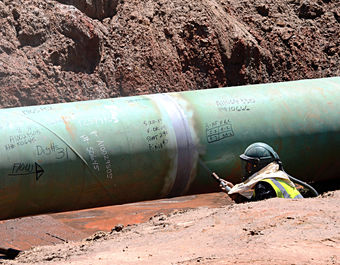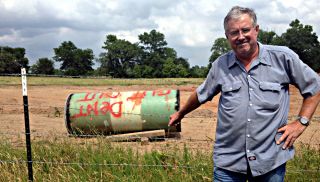 Worker
in a trench finishes replacement work on the
southern leg of the Keystone XL pipeline on a
landowner's property in Texas. Credit: Public
Citizen
Worker
in a trench finishes replacement work on the
southern leg of the Keystone XL pipeline on a
landowner's property in Texas. Credit: Public
Citizen
Story updated on Nov. 13 at 2:30 a.m. EDT to include
content of warning letters obtained by CBS from federal
regulators to TransCanada.
Story updated on Nov. 12 at 3:20 p.m. EDT to include
comments from TransCanada.
A group of environmental advocates and Texas landowners is
urging federal regulators to block TransCanada from starting the
southern leg of its Keystone XL pipeline, while new inspections
are conducted and the company's construction and safety
practices are investigated. The Oklahoma-to-Texas oil pipeline
is nearly completed.
The activists, led by the consumer advocacy group
Public Citizen, allege in
a report released Tuesday that shoddy construction on the
new line has caused more than a hundred defects that TransCanada
has had to fix. They believe the "anomalies," even after
repairs, could leave the pipeline vulnerable to breaks and
spills.
They called on the
federal
Pipeline and Hazardous Materials Safety Administration, or
PHMSA, to require comprehensive retesting and reinspection of
the line before its scheduled startup around the end of this
year.
The critics also want regulators to investigate TransCanada's
construction and quality assurance records to see why so many
repairs were needed and whether the company's practices, which
have been criticized by Canadian regulators in the past, met
safety standards. They are urging Congressional committees to
hold oversight hearings into the matter.
"What appears to be problematic construction and
corner-cutting raise questions not only about the chances of a
spill, but also about the quality of TransCanada's in-house
inspection system, as well as the ability of the federal
government to oversee the process," according to the report.
The report said the pipeline should not be allowed to carry
fuel until it has been retested with high water pressure, as
well as reinspected using robotic devices known as "smart pigs"
that can spot flaws and weaknesses.
But Richard Kuprewicz, president of the pipeline consulting
firm Accufacts Inc., called the critics' concerns exaggerated.
"There is no such thing as an anomaly-free pipeline," he said
after reviewing the report. "These are valid issues. But what I
see does not rise to the level that in my opinion and experience
would require a full hydrotest and another series of smart pig
runs."
TransCanada said the repairs show that the company is being
diligent in meeting and exceeding safety standards.
"If you use more stringent measures to find anomalies as we are
doing, you going to find more anomalies," wrote spokesman Davis
Sheremata in an email.
"Making sure that each weld, each section of pipeline and all of
the facilities are built to the higher standards we have agreed
to is what the public would expect of a responsible company," he
wrote. "The public expects us to build this pipeline safely and
to get this done right. We agree, and that's what we are doing."
The $2.3 billion, 485-mile pipeline would carry Canadian oil
from Cushing, Okla. to the Texas Gulf Coast—primarily diluted
bitumen (dilbit) from the tar sands, which is unusually hard to
clean up when it spills into water.
The pipeline would cross more than 630 streams and rivers in
Texas, where Public Citizen concentrated its attention. People
who live along the route, the report said, "face a big risk to
their land and livelihoods should this pipeline leak or
rupture."
David Whitley, a Texas landowner cited in the report, said
TransCanada returned to his 88-acre cattle ranch in May to dig
up a stretch of the pipeline. He let TransCanada cross his land
willingly, he said in an interview, but is now concerned that
"this thing might not be as safe as they are telling me."

David
Whitley stands near his fence in front of a piece of removed
pipe labeled "Dent Cut Out." Credit: Public Citizen
"I was one of those go-along guys," he said. "The pipeline is
here, and I know darn well there is nothing I can do about it as
an individual. I'm just kind of going to hope for the best."
Whitley believes the original pipe was dented because it was put
down on a large rock in the original trench, and that an
inspection detected the flaw.
Whitley said he has not yet read the Public Citizen report,
but said the group's demands reflect his wishes. "I would like
to see the pipeline tested again, and see some real oversight."
The southern segment does not need approval from the Obama
administration because it doesn't cross an international border.
Public Citizen urged the administration to consider the
alleged problems on the southern portion as it decides whether
to approve the Keystone XL's northern section. If built, that
pipeline would carry dilbit through Nebraska and cross one of
the nation's largest and most important water sources, the
Ogallala aquifer.
Treat It as a New Pipeline
Public Citizen said there were at least 125 sections on the
Keystone XL that had to be excavated and repaired during the
past six months, and possibly many more.
Kuprewicz said although he would "rather not have that
number," not every anomaly poses a serious risk. "I understand
the emotions involved," he said. "But these appear to be
attempts to delay the startup."
Public Citizen conducted its investigation by interviewing
landowners such as Whitley, visiting repair sites and flying
over sections of the pipeline. The group saw signs of several
construction problems, including dents and welds needing repair,
coating problems, improper backfilling, unintentional sags,
insufficient pipe support and erosion. It said it did not have
access to TransCanada records or those of PHMSA, the federal
pipeline safety agency.
In
documents obtained by CBS, PHMSA told TransCanada over the
past two months that it was "not following their Construction
Specifications." Regulators found a "high weld rejection rate"
on a section in which 205 welds needed repairs. TransCanada
"failed to use properly qualified welders," according to one
document.
Public Citizen worked with Evan Vokes, a whistleblower and
former TransCanada employee who has long criticized the company
for what he calls a "culture of noncompliance" with pipeline
safety codes. His disagreements with the management led to his
dismissal from the company in 2012.
Vokes said that because there are so many new welds and new
sections of pipe on the Keystone XL, it shouldn't be allowed to
carry oil until TransCanada carries out thorough inspections.
"They have taken what could have been a very strong chain and
weakened many links on the chain," Vokes said in an interview.
The Public Citizen report said PHMSA should require advanced
tests such as a hydrostatic analysis, which simulates the
pressure that will be generated later when the pipe is filled
with oil.
In an interview,
Tom Smith, director of Public Citizen in Texas, said that
new pipelines have to be carefully inspected and tested using
such methods. So it only makes sense to do the same thing again
for a line that has been patched at various points, he said.
Vokes, the former TransCanada engineer, said the sheer number
of repairs on the southern leg could be a red flag about the
company's initial work and how it was overseen. Pipeline
companies must be sure their employees and contractors are
formally “operationally qualified,” he said.
"Why are you building pipelines that have all these
problems?" he asked.
COMMENT:
I work with the people who did the research
for the report. They
are people of the highest intelligence and
integrity. Their report
is based on months of ground inspections,
flyovers, and interviews
with landowners, accompanied by Evan Vokes, a
former TransCanada
pipeline materials engineer who understands
TransCanada's history of
cutting corners and worrying about the
consequences later.
I have also met the people mentioned in the
article and visited
their land where pipeline integrity issues have
been found.
As an engineer, I understand that the
conclusions of this report are
sound. The problems are real.
Now we need to have every citizen and all
business leaders understand the serious problems
that Keystone is generating.
© InsideClimate News
http://insideclimatenews.org/news/20131112/keystone-xl-study-warns-defective-segments-pipelines-southern-leg

